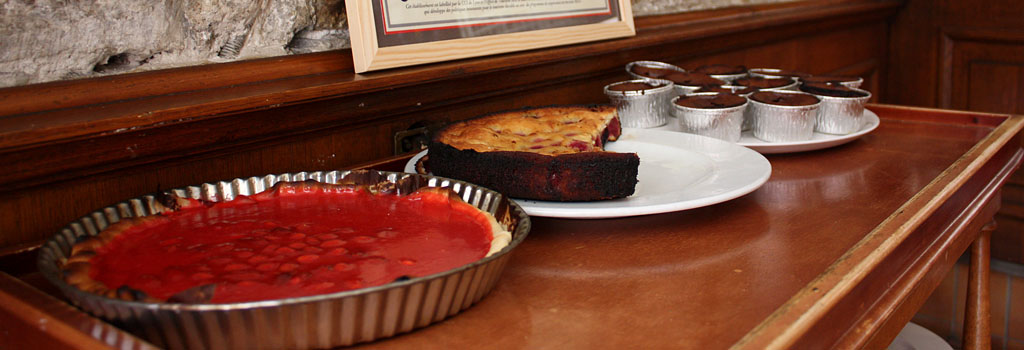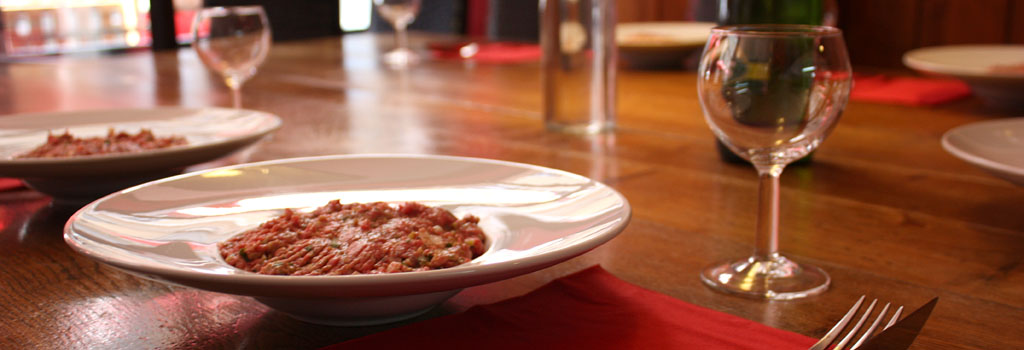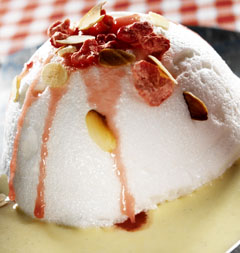The bouchons serve popular… and quality cuisine!
The dishes are very simple and prepared on site. The Bouchons use quality local produce for their cuisine.
Yes, Bouchons are synonymous with proximity: they use fresh produce which usually comes from the Lyon covered market, the Corbas National Interest Market and local markets such as the Quai Saint Antoine and Croix-Rousse markets.
This produce is used to prepare dishes typical of Lyon’s popular culture, generous, simple family dishes.
In other words, this is not the place for “An exquisite Surprise mist on a delicate cream soup” but a beautiful plate of cardoons grown in the fields!!
In keeping with tradition, all meals are accompanied by the famous pot lyonnais (carafe) of Beaujolais, Côtes du Rhône… Even the mâchon: a traditional early morning meal consisting of pork products or tripe originally prepared by the owner of the bouchon. This tradition comes from the Canuts (silk weavers) who ate at dawn after working through the night.
Local specialities include…
- Aperitif:
A meal in a bouchon always starts with an aperitif consisting of a communard (kir with red wine) and grattons: pork scratchings seasoned with salt, pepper and vinegar.
- Starter:
Starters often include Lyonnais saveloy (or cooked cured sausage). Truffle or pistachio saveloy is more finely minced than ordinary cured sausage. Brains were originally added to the recipe, hence its French name (cervelas).
- Main course:
Quenelle, from the German knödel, is the epitome of Lyon cuisine. These dumplings consist of fresh moist breadcrumbs, veal fat and poultry (or fish) meat, minced and arranged in the form of a sausage.
The tablier de sapeur (fireman’s apron) is another typical dish, based on flat tripe and deriving its name from the Maréchal de Castellane, governor of Lyon, who discovered this recipe in Spain under Napoleon III. He used to wear a leather apron, hence the name of the dish.
- Cheese:
The cervelle de canut (or claqueret) is a fairly firm type of cottage cheese, beaten and seasoned with salt, pepper, vinegar, oil, fresh herbs and garlic. Its name refers to silk workers.
- Dessert:
The Mothers were used to preparing simple and traditional desserts for bourgeois families (apple tart, île flottante, rum baba). Praline tart appeared much later, even though praline originated in Lyon.
A few easy-to-make recipes
- Cervelle de canut (a type of dip made with soft cheeses and fresh herbs) (serves 4 – 6)
– 4 ‘faisselle’ type fromage blanc cheeses, well drained
– 4 fresh goats’ milk soft cheeses
– 1 tablespoon dry white wine
– 1 teaspoon finely chopped shallots
– 1 tablespoon chopped chives
– 1 tablespoon chopped parsley
– pinch paprika
– pinch Cayenne pepper
– salt and pepper to taste
– 1 tablespoon olive oil
– 2 tablespoons crème fraîche.
Put all the ingredients in a mixing bowl and beat well together. Serve chilled but not too cold, as a dip for raw vegetables, with baked potatoes, or simply as the cheese course.
- Gras double à la lyonnaise (Lyon-style tripe) (serves 4)
– 1 kg tripe, cooked and sliced into thin strips
– 4 finely chopped onions
– 250g lard
– 1 bunch parsley, chopped
– vinegar
– dry white wine
– salt and pepper.
Melt half the lard in a deep frying pan and soften the onions in it for 5 mins. Stir in the thin strips of tripe. Cook gently for about 15 minutes. Add the remaining 125g of lard, and season with salt and pepper. As the mixture is cooking, add 15cl of dry white wine. When the tripe is golden brown, pour off the excess lard and sauté the tripe, then deglaze with the vinegar. Stir in the chopped parsley just before serving.
- • ‘Andouillette beaujolaise’ with white wine and mustard (serves 2)
– 1 x 800g andouillette beaujolaise (chitterling sausage from the Beaujolais area)
– 1 spoonful strong mustard
– 1/2 glass Macon Villages white wine
– 10cl thick crème fraîche
– Pinch chopped parsley
– Knob of butter
– 1 tablespoon groundnut oil.
Cut the sausage into 6 round slices. Heat the oil and butter in a Le Creuset style cast-iron pan and brown the sausage slices. Mix the white wine, mustard and crème fraîche together in a bowl. 2 or 3 minutes before serving, add the mixture to the slices of sausage. Reduce until sauce thickens slightly. Sprinkle with parsley just before serving.
- • Praline tart
– 1 quantity sweet or plain shortcrust pastry
– 300g crushed sugared almonds
– 30cl whipping cream.
Bake the pastry-case blind.
Put pralines and cream in a saucepan and allow to melt, then simmer until the mixture forms a ribbon when allowed to drop from the spoon. Pour into the pastry-case and leave to set before serving.






 When the Mothers were working for bourgeois familie...
When the Mothers were working for bourgeois familie...